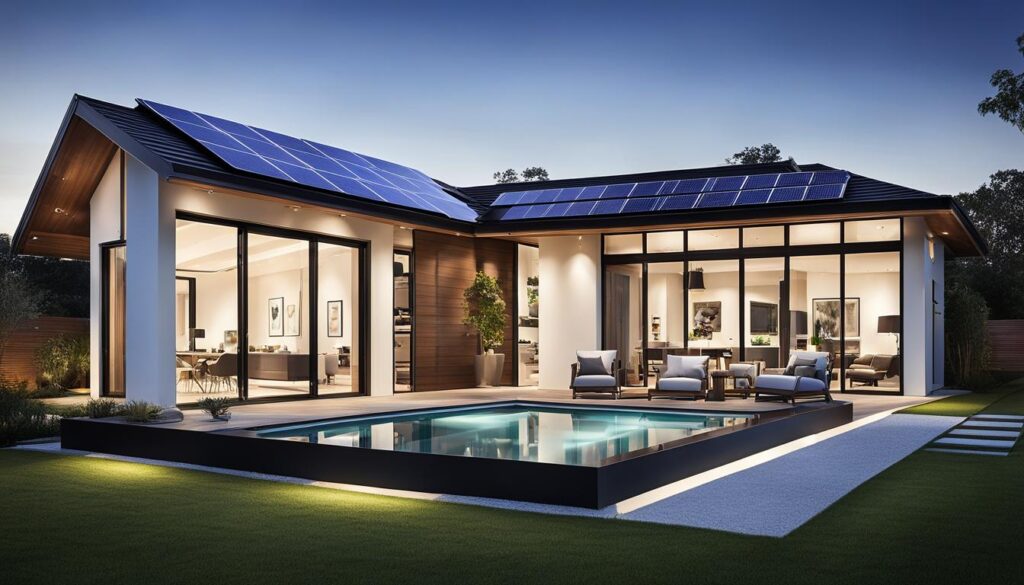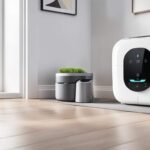As a homeowner, I understand the importance of energy efficiency in smart homes. With the rise of smart home automation, there are now more opportunities than ever to make our homes more energy-efficient. In this article, I will provide you with some starter tips to help you optimize energy usage in your smart home and reap the benefits of reduced energy bills and a greener environment.
Table of Contents
Key Takeaways:
- Implementing smart home automation can significantly increase energy efficiency.
- Smart thermostats allow for remote control and scheduling, leading to energy savings.
- Smart lighting systems can automate lighting schedules and reduce energy waste.
- Energy monitoring devices and smart plugs help track and control energy consumption.
- Integrating renewable energy sources like solar panels can further enhance energy efficiency.
The Importance of Energy Efficiency in Smart Homes
Energy efficiency plays a crucial role in smart homes. By reducing energy consumption, you not only save money but also contribute to a greener environment. According to research, energy-efficient homes can reduce energy usage by up to 30%. This translates to significant savings on utility bills and a reduced carbon footprint.
Implementing smart home automation can further enhance energy efficiency by allowing you to monitor and control energy usage in real-time. With smart technology, you have the power to optimize your home’s energy consumption, ensuring that energy is only used when needed and avoiding unnecessary waste.
“Energy efficiency is not just about saving money; it is also about making a positive impact on the planet. By reducing our energy consumption and embracing smart technologies, we can contribute to a sustainable future.”
Whether it’s turning off lights automatically when no one is in the room, adjusting temperature settings based on your daily routine, or remotely controlling appliances to prevent standby power consumption, smart home automation empowers you to maximize energy efficiency effortlessly.
By incorporating energy-efficient practices into your smart home, you can play a part in conserving resources, reducing greenhouse gas emissions, and creating a more sustainable living environment for future generations. The benefits extend beyond financial savings, providing a sense of fulfillment in contributing to a cleaner and greener world.
Smart Thermostats for Energy Savings
When it comes to achieving energy savings in your smart home, one of the most effective solutions is to install a smart thermostat. Brands like Nest and Ecobee offer popular models that can revolutionize your home’s heating and cooling systems. With a smart thermostat, you gain the ability to control your temperature settings remotely, adjusting them based on your preferences and occupancy patterns.
By optimizing temperature settings and creating personalized schedules, you can significantly reduce energy waste and save up to 10% on both heating and cooling costs (Second source). Imagine being able to effortlessly lower your energy consumption without sacrificing comfort.
With a smart thermostat, you no longer need to worry about forgetting to adjust the temperature when you leave the house. You can easily monitor and control your thermostat through a mobile app, ensuring that your home is always at the ideal temperature when you return.
But the benefits don’t stop there. Smart thermostats also offer features such as geofencing, which uses your smartphone’s location to automatically adjust temperature settings, ensuring optimal energy efficiency. If you step out for a while, the system can set your thermostat to an energy-saving mode, reducing energy consumption while you’re away.
“Installing a smart thermostat is like having a personal energy manager at your fingertips. It enables you to effortlessly control your home’s temperature and unlock significant energy savings.”
With the ability to analyze your energy usage patterns and provide insights, smart thermostats empower you to make more informed decisions about your energy consumption. By understanding when and how much energy you use, you can make adjustments to further optimize efficiency.
To give you a better idea of the potential energy savings, here’s a comparison of traditional thermostats and smart thermostats:
| Traditional Thermostats | Smart Thermostats |
|---|---|
| Manual adjustment required | Remote control and automation capabilities |
| Fixed temperature settings | Customizable temperature schedules |
| No insights or data on energy usage | Real-time energy consumption monitoring |
| Higher energy waste due to manual oversight | Optimized energy usage based on occupancy patterns and preferences |
As you can see, smart thermostats revolutionize the way you interact with your home’s climate control systems, offering convenience, customization, and energy savings. With these advanced devices, you can actively contribute to a greener future while enjoying the benefits of a comfortable living environment.

Takeaways:
- Smart thermostats allow remote control and automation of temperature settings.
- Customizable temperature schedules and occupancy-based adjustments optimize energy usage.
- Real-time energy consumption monitoring provides insights and opportunities for further efficiency improvements.
- Comparison with traditional thermostats showcases the vast advantages of smart thermostats when it comes to energy savings.
Lighting Automation for Efficient Energy Use
When it comes to energy efficiency in smart homes, lighting automation plays a crucial role. By harnessing the power of smart lighting systems, such as Philips Hue or Lutron Caseta, you can optimize your lighting usage and make significant strides in conserving energy.
With lighting automation, you have the ability to set up automated lighting schedules, allowing your lights to turn on and off at specific times. This ensures that lights are only used when necessary, reducing unnecessary energy consumption. You can also take advantage of timer settings, enabling lights to automatically dim or turn off after a predetermined period of inactivity.
Moreover, integrating motion sensors into your smart lighting system adds an extra layer of efficiency. These sensors detect movement in a room and activate the lights accordingly, ensuring that lights are only illuminated when someone is present. This feature is especially useful in rooms where people tend to forget to turn off the lights, such as bathrooms, closets, and basement areas.
By implementing lighting automation in your smart home, you can achieve substantial energy savings and contribute to a more sustainable future. Not only does it lead to reduced electricity bills, but it also extends the lifespan of your bulbs, minimizing waste. According to Third source, implementing smart lighting systems can result in energy savings of up to 40%, making it a cost-effective and environmentally-friendly option.
| Benefits of Lighting Automation | Source |
|---|---|
| Reduced energy consumption | Third source |
| Lower electricity bills | Third source |
| Prolonged bulb lifespan | Third source |
| Contributes to a greener environment | Third source |
By leveraging the power of lighting automation, you can make your smart home more energy-efficient and create a comfortable living space while minimizing waste. Installing smart lighting systems and motion sensors is a step towards a greener future.

Energy Monitoring and Smart Plugs
To gain a better understanding of your energy usage and identify areas for improvement, consider installing energy monitoring devices in your smart home. These devices, such as Sense or Curb, provide real-time data on your energy consumption, allowing you to identify energy-hungry appliances and take steps to reduce their usage. Additionally, the use of smart plugs can help you control the power supply to individual devices, reducing standby power consumption and saving energy.
By monitoring your energy usage, you can make informed decisions to optimize efficiency and reduce wastage. Energy monitoring devices provide detailed insights into how much energy your appliances are consuming, helping you identify inefficiencies or high-energy-consuming devices that may need attention.
The real-time data provided by energy monitoring devices empowers you to take proactive measures to reduce your energy consumption. You can track the impact of your energy-saving efforts and make adjustments accordingly.
Benefits of Energy Monitoring Devices:
- Accurate real-time data: Energy monitoring devices provide accurate and up-to-date information on your energy usage, allowing you to make informed decisions.
- Identify energy-hungry appliances: By analyzing the data provided by energy monitoring devices, you can identify appliances that consume excessive energy and take steps to reduce their usage.
- Track energy saving progress: With energy monitoring devices, you can track the impact of your energy-saving efforts over time and make adjustments as needed.
- Reduce standby power consumption: Smart plugs enable you to control the power supply to individual devices, eliminating standby power consumption which can account for a significant portion of your energy usage.
Integrating energy monitoring devices and smart plugs into your smart home system allows you to have full control over your energy usage. By identifying energy-saving opportunities and implementing measures to reduce energy waste, you can not only save money on your utility bills but also contribute to a more sustainable future.
| Energy Monitoring and Smart Plugs | Benefits |
|---|---|
| Gives accurate real-time data on energy consumption | Allows you to make informed decisions and take action |
| Identifies energy-hungry appliances | Helps you reduce their usage and save energy |
| Tracks energy-saving progress over time | Enables you to make adjustments as needed |
| Reduces standby power consumption | Smart plugs eliminate energy wasted by devices on standby |
Integration of Renewable Energy Sources
Maximizing energy efficiency in your smart home goes hand in hand with the integration of renewable energy sources. By harnessing the power of renewable resources such as solar panels or wind turbines, you can generate clean and sustainable energy to power your home. This not only reduces your reliance on non-renewable sources but also contributes to minimizing your carbon footprint.
Renewable energy sources offer numerous advantages for your smart home. They provide a constant and reliable source of energy while being environmentally friendly. By leveraging these sources, you can take a significant step towards creating a more sustainable living environment.
Benefits of Integrating Renewable Energy Sources:
- Reduced reliance on non-renewable sources: By utilizing renewable energy sources, you can decrease your dependence on fossil fuels and other non-renewable resources. This not only ensures a more sustainable energy supply but also helps to mitigate the environmental impact associated with the extraction and burning of these fuels.
- Minimized carbon footprint: Renewable energy sources produce electricity without emitting greenhouse gases or other harmful pollutants. By integrating these sources into your smart home, you can significantly reduce your carbon footprint and contribute to mitigating climate change.
- Energy cost savings: Over time, harnessing renewable energy sources can help you save on your electricity bills. While the initial installation costs may be higher, the long-term savings derived from renewable energy production can offset these expenses.
- Reliable and independent energy supply: Renewable energy sources offer a more reliable and constant energy supply compared to traditional sources. By generating your own electricity, you can become less dependent on the power grid and protect yourself against potential blackouts or fluctuations in energy prices.
Integrating renewable energy sources into your smart home can be done in various ways, depending on your location, available space, and budget. Solar panels are a popular choice, as they can be installed on rooftops or in open spaces to capture sunlight and convert it into electricity. Wind turbines can also be considered if you have sufficient land and live in a windy area.
Smart home automation can further enhance the integration of renewable energy sources by optimizing their use. For instance, excess energy generated by solar panels can be automatically redirected to storage devices, such as batteries, for later use when energy demand exceeds supply. This ensures efficient utilization of the generated energy and minimizes wastage.
By integrating renewable energy sources into your smart home, you are not only taking a step towards a more sustainable future but also reaping the benefits of reduced energy costs and increased energy independence. Embrace the power of renewables and make your smart home a beacon of clean energy innovation.
Smart Home Energy Management Systems
To streamline energy usage and maximize efficiency in your smart home, investing in a smart home energy management system is a wise choice. These systems, such as Schneider Electric’s Wiser or Google’s PowerMeter, provide centralized control and monitoring of various energy-consuming devices and systems in your home.
One of the key features offered by these energy management systems is energy usage dashboards. These dashboards provide real-time data and insights into your energy consumption, allowing you to make informed decisions about your energy usage. By visualizing your energy consumption patterns, you can identify areas of improvement and adjust your energy settings accordingly.
Another advantage of smart home energy management systems is the ability to set automated energy-saving modes. These modes can be programmed to adjust your smart devices and systems based on your preferences and occupancy patterns. For example, when you’re away from home, the system can automatically lower the temperature settings, dim the lights, and reduce the power usage of non-essential devices. By optimizing your energy usage, you can save money on utility bills and reduce your environmental impact.
Furthermore, integrating renewable energy sources into your smart home becomes seamless with energy management systems. These systems can facilitate the integration and coordination of solar panels, wind turbines, and other renewable energy sources. By intelligently directing excess energy generated by these sources, you can store it in batteries or redirect it to other appliances when they need it the most. This maximizes the utilization of renewable energy and further reduces your reliance on non-renewable sources.
Overall, with smart home energy management systems, you can achieve better energy management and optimize your smart home’s energy efficiency. These systems provide centralized control, real-time monitoring, and energy-saving features to help you reduce waste, save money, and contribute to a sustainable future.
| Benefits of Smart Home Energy Management Systems | Features |
|---|---|
| Centralized control | Remotely monitor and control energy-consuming devices and systems in your home. |
| Real-time data | Access energy usage dashboards to visualize and analyze your energy consumption patterns. |
| Automated energy-saving modes | Program your smart devices to optimize energy usage based on your preferences and occupancy patterns. |
| Integration with renewable energy sources | Effortlessly integrate solar panels, wind turbines, and other renewable energy sources into your smart home setup. |
Conclusion
In conclusion, smart home automation offers great potential for enhancing energy efficiency in your home. By following these starter tips and incorporating smart technologies, you can significantly reduce energy waste, save money on utility bills, and create a greener living space.
Energy efficiency is not only beneficial for the environment but also contributes to a more sustainable future for our planet. By taking small steps towards a more energy-efficient smart home, you are making a positive impact and setting an example for others to follow.
Remember, the key to maximizing energy efficiency is the integration of various smart devices and systems. From smart thermostats to lighting automation, energy monitoring, and the incorporation of renewable energy sources, each step can make a significant difference in your overall energy consumption.
So, start your journey towards a more energy-efficient smart home today. Embrace the power of smart home automation, implement these starter tips, and enjoy the benefits of reduced energy consumption, lower utility bills, and a more sustainable lifestyle.
FAQ
What are the benefits of smart home automation for energy efficiency?
Smart home automation offers numerous benefits for energy efficiency, including reduced energy consumption, cost savings on utility bills, and a smaller carbon footprint. By monitoring and controlling energy usage in real-time, you can optimize energy efficiency and contribute to a greener environment.
How can I achieve energy savings in my smart home?
One of the most effective ways to achieve energy savings in your smart home is by installing a smart thermostat. Smart thermostats, such as Nest and Ecobee models, allow you to remotely control your heating and cooling settings and adjust them based on your preferences and occupancy patterns. By optimizing temperature settings and creating schedules, you can save up to 10% on heating and cooling costs.
How can smart lighting systems contribute to energy efficiency?
Installing smart lighting systems, such as Philips Hue or Lutron Caseta, can significantly improve energy efficiency. These systems allow you to automate lighting schedules, set timers, and dim lights when they are not needed. Additionally, integrating motion sensors ensures that lights are only turned on when someone is present in a room, leading to substantial energy savings and longer bulb lifespan.
How can energy monitoring devices help improve energy efficiency in my smart home?
Energy monitoring devices, such as Sense or Curb, provide real-time data on your energy consumption, allowing you to identify energy-hungry appliances and take steps to reduce their usage. Additionally, the use of smart plugs can help you control the power supply to individual devices, reducing standby power consumption and saving energy.
How can I integrate renewable energy sources into my smart home?
To maximize energy efficiency, consider installing solar panels or wind turbines to generate clean energy for your home. By reducing reliance on non-renewable sources, you can minimize your carbon footprint and contribute to a sustainable future. Smart home automation can optimize the use of renewable energy by automatically redirecting excess energy to storage devices or other appliances when needed.
What are smart home energy management systems and how can they help?
Smart home energy management systems, such as Schneider Electric’s Wiser or Google’s PowerMeter, provide centralized control and monitoring of energy-consuming devices and systems in your home. These systems offer features like energy usage dashboards, automated energy-saving modes, and integration with renewable energy sources. By utilizing these systems, you can achieve better energy management and optimize your smart home’s energy efficiency.


